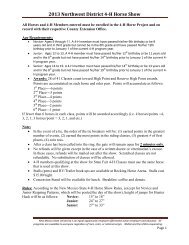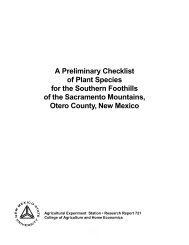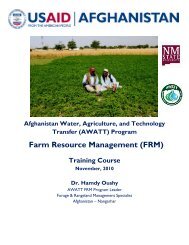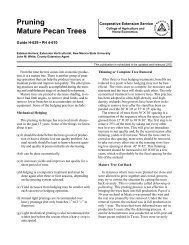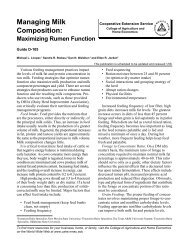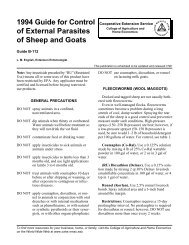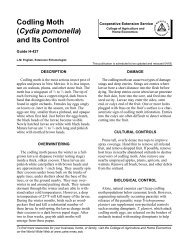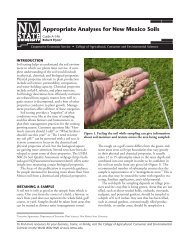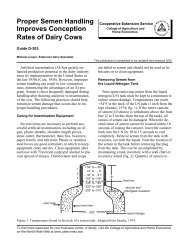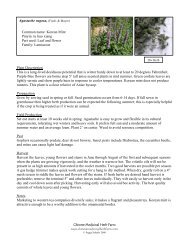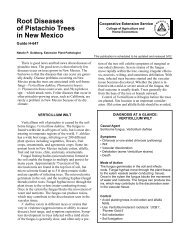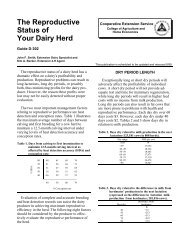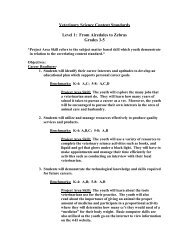New Mexican green chiles, are highly susceptible towater loss, sunscald, and heat damage. These problemsare likely to occur if chiles are allowed to sit for morethan an hour in direct sunlight. <strong>Fresh</strong> chile harvestedin the summertime can have pulp temperatures <strong>of</strong> 90°F(32°C) or more. For these reasons, chiles should be harvestedin the early morning, placed in the shade, andcooled as soon as possible. If the chiles are not cooledwithin 1 to 2 hours, they will begin to show signs <strong>of</strong>water loss and s<strong>of</strong>tening.Most fresh chile is harvested by hand into bucketsor sacks and then emptied into bulk bins for transportto the packing shed or processor. A field <strong>of</strong> long greenchiles can be harvested in early August and then againin September. A third harvest will typically yield smallfruits and may not be pr<strong>of</strong>itable.Once at the shed, the chile is either dry-dumpedonto padded ramps or moving conveyor belts, or wetdumpedinto a chlorinated wash tank. Wash tanksshould be cleaned daily, and the chlorination levelsshould be monitored frequently. These sanitation practicesare necessary because chiles are highly susceptibleto bacterial diseases that could be introduced throughthe wash tanks. Fruits are then sorted to remove diseased,overripe, immature, or otherwise defective pods.Grading according to USDA or other market standardscan be done after sorting.<strong>Fresh</strong> chile is typically packed in 1 1/4 bushel sizecorrugated cartons that hold 30 lb. Another packagetype is the 2-piece telescope style, with a lid that fitsover the body. The boxes may be waxed, and shouldhave top and bottom gaps and side slots for ventilationand cooling. Cartons should be sufficientlystrong to endure stacking and shipping. Boxes shouldbe stacked in a 3 × 2 cross-stack pattern, 6 high on a40 × 48-in. pallet.Packages with plastic (polyethylene) liners or bagshave an additional barrier to fruit moisture loss. Plasticfilms reduce water loss from the chiles, but may interferewith cooling efficiency. Small perforations in theplastic will compensate for the barrier by improvinggas exchange and increasing the airflow during coolingand storage. <strong>Chiles</strong> can also be packaged in smallconsumer units for retail markets using plastic bags ortrays wrapped with films. These retail packages can beprepared at the packing shed or, more commonly, at thedistribution center.Both storage temperature and package container influencechile fruit weight loss (Figure 1). <strong>Chiles</strong> storedin boxes have a daily weight loss <strong>of</strong> about 3.5% at 75°F(24°C), but only 0.5% at 46°F (8°C). The use <strong>of</strong> plasticwrappedtrays or polyethylene bags decreases fruit weightloss further, especially at lower storage temperatures.Figure 1. Percent weight loss <strong>of</strong> New Mexican long greenchile stored at either 75°F (24°C) or 46°F (8°C) andpackaged in boxes, wrapped trays, or polyethylene bags.During the first week <strong>of</strong> storage, boxed fruit had a dailyweight loss <strong>of</strong> 3.5% at 75°F and 0.5% at 46°F.COOLING AND STORAGE<strong>Fresh</strong> chile is a highly perishable commodity. Propercooling extends the shelf life by slowing respiration, waterloss, color change, and decay. Temperatures higherthan 70°F (21°C) greatly accelerate ripening throughrespiration and ethylene production. Preferred coolingmethods for chiles are room cooling and forced-air cooling.Cooling and storage are independent operations andthe specific requirements for rapid cooling should thereforebe considered separately from cold storage needs.Room cooling exposes fresh produce to cold air in arefrigerated space. Bins or boxes must be stacked properlyto permit airflow between the individual storage units.Room coolers can be partitioned into sections so thatrecently harvested chiles with high field heat are keptseparate from previously cooled produce. Powerful fansand ceiling jets can be used to increase the airflow and,consequently, the cooling efficiency <strong>of</strong> room coolers.Forced-air cooling is an active cooling process and ismuch faster at removing field heat than room cooling.With forced-air cooling, fans pull cool air through theboxes or bins <strong>of</strong> produce. Room coolers can be modifiedinto forced-air coolers relatively quickly and inexpensivelyby adding extra fans and partitions.Guide H-235 • Page 2
Figure 2. Diagram <strong>of</strong> a forced-air cooling tunnel design.There are several variations <strong>of</strong> forced-air cooling designs;the most common is the forced-air tunnel design(Figure 2). In this system, a row <strong>of</strong> bins or palletizedboxes is placed on either side <strong>of</strong> an exhaust fan, creatingan aisle between the two rows. The aisle and open endare covered with canvas to form a tunnel. The exhaustfan creates negative pressure in the tunnel and pulls coldair through the stacks to cool the produce. Containersmust be adequately vented for proper airflow duringforced-air cooling.Forced-air evaporative cooling is a system that usesevaporative coolers instead <strong>of</strong> refrigeration units. Thiscooling system is practical in New Mexico because <strong>of</strong>our arid climate. An evaporative cooler is more energyefficientthan mechanical refrigeration, and growers canbuild their own systems. Forced-air evaporative coolerscan lower the product temperature to about 60°F(16°C) and are most useful for chilling sensitive commodities(such as chiles) intended for a local market.The optimum storage conditions for fresh chilesare 45 to 50°F (7-10°C) and 90 to 95% relative humidity.Chilling injury occurs at lower temperatures.The symptoms <strong>of</strong> chilling injury are s<strong>of</strong>tening, pitting,and an increased susceptibility to decay. Freeze damageoccurs at 32°F (0°C). Most fresh chiles can be storedfor 2 to 3 weeks if kept cool at the proper temperature.<strong>Chiles</strong> should be shipped on refrigerated trucks, butthese vehicles should not be used for pre-cooling becauserefrigerated trailers do not have adequate coolingcapacity or ventilation to remove field heat quickly.Transit cooling is intended only to keep previouslycooled produce cold during shipping.Poor temperature management and ethylene accumulationduring storage or transit promote ripeningand decay. Some fruits and vegetables produce muchlarger quantities <strong>of</strong> ethylene than chiles. For that reason,chiles should never be stored or shipped with crops suchas tomatoes, apples, or melons. Storage rooms shouldbe ventilated properly to reduce the accumulation <strong>of</strong>ethylene in the environment. Placing ethylene scrubberscontaining potassium permanganate in the storage roomor transit vehicle can also decrease ethylene levels.Maintaining a chain <strong>of</strong> quality from grower throughconsumer is essential when handling fresh chiles. Thebasis <strong>of</strong> the chain <strong>of</strong> quality is proper cooling, butminimizing mechanical injuries, diseases, and ethyleneexposure are also critical for maximum chile quality.Original author: Marisa M. Wall, former assistantpr<strong>of</strong>essor <strong>of</strong> horticulture.Guide H-235 • Page 3



